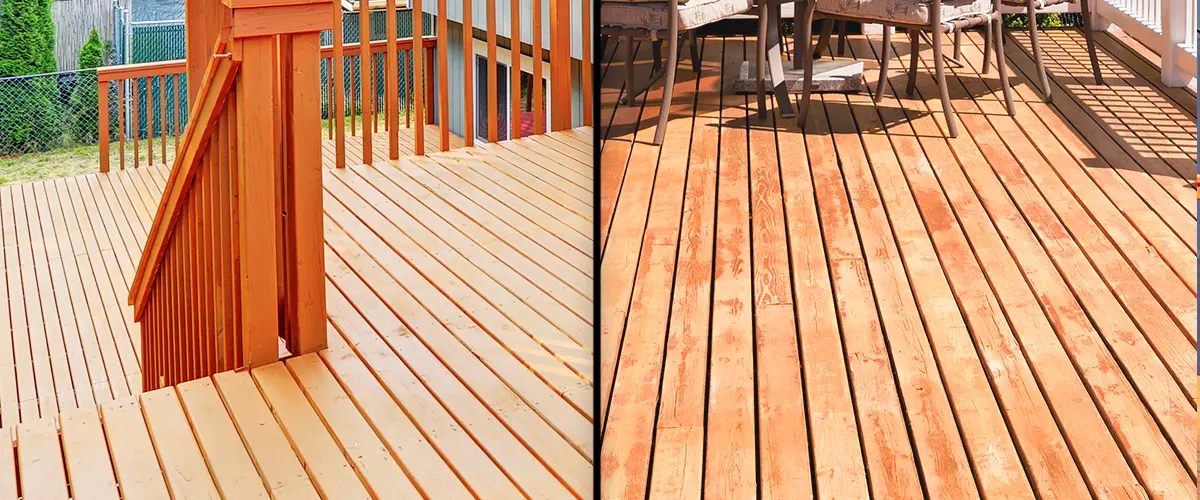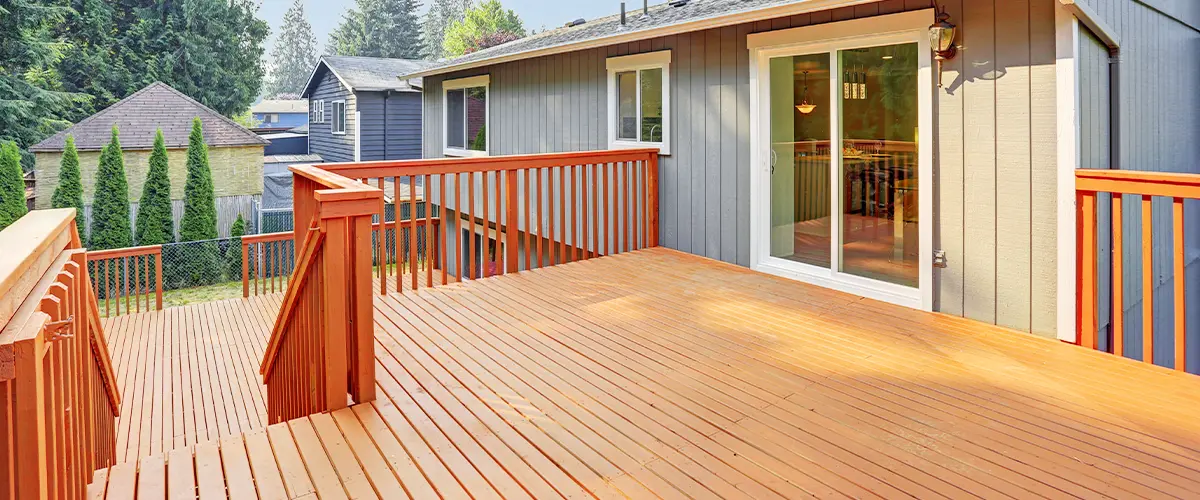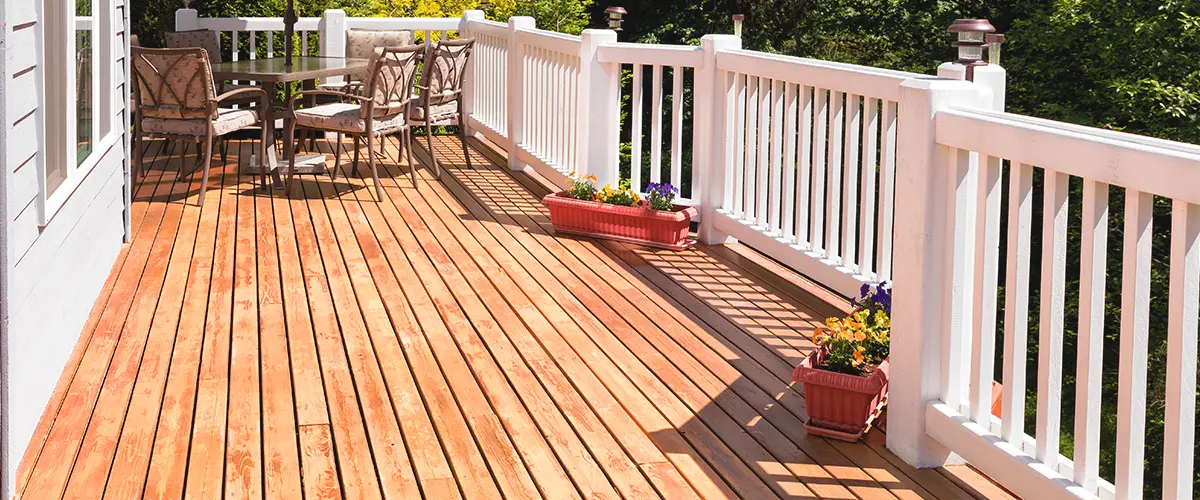Redwood Vs Cedar: Which is Better for Decks?
Choosing between redwood vs cedar deck can be tough. Both woods have unique qualities that make them popular for outdoor decking. This article compares the appearance, environmental impact, durability, and maintenance of redwood and cedar to help you make an informed decision for you new deck building project.
Discover your perfect wood choice for a beautiful deck.

- Redwood decks are stronger with a higher Janka rating of 480, while cedar has a rating of 350, making redwood more durable for areas with lots of foot traffic.
- Cedar costs less initially, between $4-$6 per square foot, but might need more upkeep over time. Redwood's cost starts at $7-$8 per square foot but is less likely to require repairs or replacements.
- Both woods come from sustainable forests and have eco-friendly qualities like insect resistance and the ability to be harvested responsibly.
- To keep both types of decks looking good, you'll need to clean them regularly, apply stain every 2-3 years, seal them from moisture, and check for damage or pests often.
- Choosing between cedar and redwood depends on what you value more: cedar's affordability and lighter color or redwood's durability and rich reddish hue.
Appearance Comparison of redwood & Cedar
Redwood and cedar have distinct colors and grain patterns. Redwood carries a reddish-brown hue with fewer knots, while cedar boasts a lighter natural color and typically has narrower knots.
Redwood vs Cedarwood - Colors
Cedar has a light natural color, often showing off a yellowish tone that can add warmth to any deck design. This lighter hue makes cedar decking stand out, especially when it absorbs stains and finishes, allowing homeowners to customize their outdoor space easily.
On the other hand, redwood boasts a rich reddish-brown hue that deepens over time. The natural beauty of redwood is unmistakable, giving your deck an elegant look without needing much in the way of stain or paint.
No matter which wood you choose—cedar for its bright and customizable color or redwood for its timeless elegance—the decision will dramatically influence the aesthetic appeal of your deck.

Grain patterns of Redwood and Cedarwood
Redwood decking displays a distinct grain that contributes charm to outdoor locations. This timber is sourced from the forests of Northern California, where redwood trees exhibit a pattern that’s typically regular and consistent.
Its fine-to-medium textured nature augments the allure of decks, making them visually attractive. Redwood usually has less knotting relative to other woods, therefore, its surface is smoother and visually more captivating.
In contrast, Western red cedar also presents a unique grain, but it veers more towards an assorted look. Western red cedar from the West Coast shows grains that vary from strictly linear to gently undulating, adding to its country-like appeal.
Cedar’s texture is slightly more rugged than redwood, injecting intrigue and depth to decking boards. It’s worth mentioning that both cedar and redwood provide higher-quality choices for those who prefer fewer flaws in their wood choices.
Redwood and Cedarwood: Environmental Impact
Redwood and cedar are both known for their eco-friendliness and sustainability, making them good choices for homeowners who prioritize environmental impact in their decking materials.
The growth of redwood seedlings is managed through sustainable practices, while western red cedar is harvested primarily from sustainable forests.
Eco-friendliness
Selecting environmentally considerate materials for deck boards is significant for homeowners. Particularly, Western Red Cedar and California Redwood stand out with their sustainable development.
Forest Stewardship Council verifies these woods as green choices due to conscientious harvesting practices. This signifies new trees are cultivated to balance the ones harvested, confirming a perpetual cycle of growth.
Cedar and Redwood saplings significantly contribute to this cycle, with providers emphasizing sustainability.
For those attentive to environmental impacts, opting for cedar or redwood can be a mindful decision. These types of wood provide natural beauty and originate from forests supervised for sustainable growth.
Primarily, they are harvested from areas devoted to preserving forest health, hence, cedar and redwood products comply with high green standards. Mature trees are frequently chosen for harvesting while ensuring the annual growth rates of younger trees in the forest.
Sustainability
Redwood and cedar are both highly sustainable choices for decking. Western red cedar grows specifically in the Pacific Northwest, making it a locally sourced and renewable option. It is naturally insect-resistant, reducing the need for chemical treatments, which makes it environmentally friendly.
Redwood also boasts eco-friendly properties as it comes from responsibly harvested trees. Both woods contribute to sustainable practices in their own right, making them excellent options for homeowners seeking environmentally conscious deck materials.
Both redwood and cedar are known for being environmentally friendly due to their insect resistance and responsible harvesting practices. These qualities make them great options for homeowners looking to invest in sustainable deck materials that have minimal impact on the environment.
Durability and Maintenance
Redwood and cedar both boast high durability, making them ideal for outdoor applications. They require minimal maintenance due to their natural resistance to rot and insects.

Comparison of strength (Janka rating)
When considering the best wood for your deck, it’s critical to compare the strength of redwood and cedar, as determined by their Janka hardness ratings. This rating measures the wood’s resistance to wear and tear, giving you a clear idea of how each might hold up over time. Here’s a concise comparison presented in an easy-to-understand table format:
| Wood Type | Janka Rating (pounds-force) |
|---|---|
| Redwood | 480 |
| Cedar | 350 |
This table reveals that redwood possesses a higher Janka rating compared to cedar, indicating its superior strength and durability for decking materials. This distinction highlights why homeowners might prefer redwood for areas experiencing higher foot traffic or for structures requiring a more robust material. Now, let’s move on to examine the cost implications of choosing either wood for your deck.
Cost comparison
Choosing the right materials for your deck involves considering the cost. Budget can significantly impact your decision between redwood and cedar. Here’s a straightforward comparison of the two in terms of upfront material costs and long-term value.
| Wood Type | Initial Cost per Square Foot | Long-Term Value |
|---|---|---|
| Redwood | $7-$8 | High durability can lead to lower costs over time due to less frequent replacements and repairs. |
| Cedar | $4-$6 | Requires more maintenance, which might increase costs in the long run, but still offers a decent lifespan. |
This table reflects the general market trends for the costs associated with redwood and cedar. Keep in mind that prices can vary based on your location, the quality of the wood, and market conditions. Redwood usually commands a higher price due to its superior qualities, including its longevity and resistance to decay.
Cedar, while initially more affordable, may require more upkeep, potentially leading to higher costs over the lifespan of your deck. Your decision should align with both your immediate budget and long-term investment considerations.
Maintenance requirements of Cedarwood vs Redwood
Maintaining a cedar or redwood deck requires regular care to ensure its longevity and endurance. Here’s what you need to know about the maintenance requirements for each wood:
- Regular Cleaning: Both cedar and redwood decks benefit from regular cleaning with a mild soap and water solution to remove dirt, grime, and mildew.
- Staining: Applying a protective stain every 2-3 years helps maintain the wood's natural beauty and protects it from the elements such as UV rays, moisture, and rot.
- Sealing: Sealing the deck after staining provides an extra layer of protection against moisture, preventing warping, cracking, and decay.
- Inspection: Periodically inspecting the deck for signs of wear, damage, or pest infestation allows for timely repairs and ensures the longevity of the structure.
Best Manufacturers of Cedar and Redwood Products
When selecting cedar or redwood for decking, consider these top manufacturers renowned for quality and sustainability.
- Western Red Cedar Lumber Association: Offers a range of sustainably sourced cedar products, promoting environmentally responsible practices in forestry.
- Redwood Lumber and Veneer Company: Specializes in premium redwood products, known for their durability and natural beauty in various applications.
- Cedar Wood Products: Provides a diverse selection of cedar decking, emphasizing quality craftsmanship and eco-friendly harvesting methods.
- Timber Products Company: Renowned for their sustainable lumber solutions, combining strength and beauty in their redwood and cedar offerings.
- Mendocino Redwood Company: Focuses on forest conservation and eco-friendly harvesting while providing high-quality redwood products for decking and more.
FAQs about Cedarwood and Redwood
Redwood decks often have a reddish-brown hue, while cedar decks can turn to silver gray over time. Cedar is naturally resistant to insect damage, just like redwood. However, in terms of grade availability, redwood wins by a narrow margin.
Both types of wood are harvested responsibly and offer an eco-friendly alternative to other materials. The growth of western red cedar and Humbolt Redwood seedlings contribute positively to the environment.
Both woods are known for their durability with almost identical tips from professionals on this matter! They’re both rot-resistant and offer good weather resistance too.
Cedar has a typically fewer knots compared to other wood types which gives it a smooth look whereas Redwoods’ older trees possess a unique aesthetic appeal with its reddish brown hue that looks stunning under tinted stain or iron stains!
Important factors worth mentioning include your personal aesthetic preferences, budget considerations as well as professional advice on overall quality & longevity from reliable cedar suppliers or those dealing specifically in western-red-cedar products.
For maintaining the original color against weathering effects,a slight edge goes towards using oxalic acid-based product but ultimately decide based on your exact science after adequate research into same board care instructions whether it’s Douglas fir ,cedar or more Redwoods!
Experience You Can Trust
Our team has been providing quality decking services for years, showcasing our professionalism and expertise. Opt for the best to save money over time.
Ready to tackle your deck building project? Contact us at (443) 926-6996 to get started.
